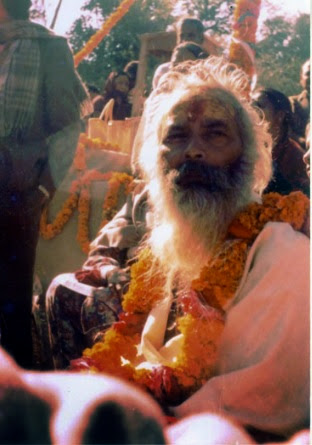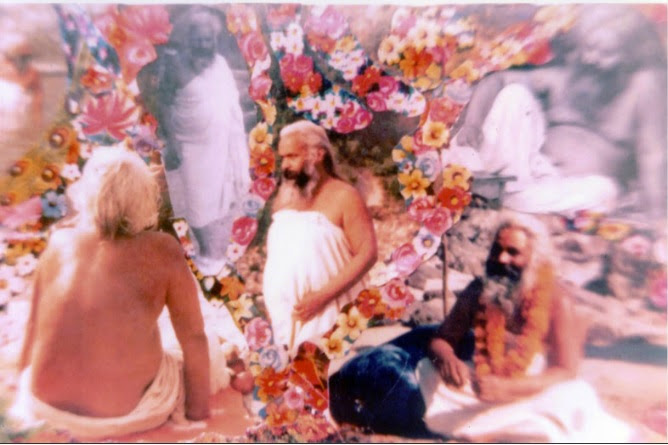Mahasamadhi
When the Kumbha Mela was held in Haridwar in April, 1986, many pilgrims paid visits to Babaji and touched his feet in reverence. Babaji soon began to suffer from fever, which was a usual phenomenon for him after a Kumbha Mela. Whenever babaji had fever he would not eat anything. Normally when the fever was over, he would start to take his usual meals. But this time Babaji did not begin taking food again in a normal manner. His food intake remained substantially reduced and as a consequence, his body began to emaciate. According to Rishipalji, Babaji almost gave up taking food after Govardhana Puja (Annakuta day) in 1986. On Hanuman Jayanti, 13th April, 1987, Babaji’s body became so weak that he could not go to Hanuman Shila as he usually did on this day. However, he was looking fairly okay, when I left for Delhi after my Navaratri fast on Gangajal. Naniji told me that when the summer had properly set in, Babaji grew much weaker. In this situation it was difficult for him to move in and out of the Gufa. Once when he was walking back from Dharmashala to the Gufa, he became exhausted and stopping near the small window of the Gufa rested his head on the stone above the Gufa. He said, ”Babaji cannot go to the Dharmashala again”.
When, because of his deteriorating physical state, it became difficult for Babaji to climb in and out of the gufa for normal physical functions, a grass hut was made at the place which at present is known as the Samadhi. The hut had two parts. A larger room where Babaji slept and gave darshan to his devotes and a smaller room which was used by Babaji to attend the calls of nature. As long as possible Babaji, would come slowly out of his hut and sit in front of it so that a larger number of devotees could have his darshan. Aarti was also held there in front of the hut. Although Babaji did not feel like eating, the devotees would try to coax him to eat something. Gradually, he was only taking liquids and later only the water of tender coconuts which a devotee regularly sent from Delhi. Occasionally towards the end of his life Babaji would vomit saliva. Afraid of causing Babaji any discomfort while cleaning his beard and moustache the devotees requested him that he might have a shave so that caring for him would not be troublesome for him. He gave his consent. Babaji was always very delicate. I myself felt the tenderness of his calves whenever I fortunately got the opportunity to massage his legs. Now because of his extreme weakness and delicacy, he was shaved while his head was kept in Nani’s lap.

Two or three weeks before he gave up his physical form, he took only fresh coconut water. Afterwards, Babaji gave up even the coconut water and only took sips of Gangajal. Devotees were brokenhearted about his state of health and tried to help him each in their own way. Babaji, in his compassion for their feelings, allowed them to do whatever they wanted to do. At this point some devotees gave him allopathic medicine as well as a variety of traditional medicines and therapies and one day one devotee even administered a glucose drip. Another called a doctor who examined Babaji and said that there was some lump in the abdomen, which could be a tumour or an entanglement of intestines due to absence of food and liquid intake. After examining Babaji, he said that the body was not likely to remain for more than 72 hours.
On the afternoon before Babji entered Mahasamadhi, he asked someone to help him sit up. When he was in a sitting posture, he surprisingly performed a hatha yoga kriya known as Nauli. Later in the evening of the same day while inside the hut he told Nani that there were two Vaishnava babas outside who should be fed and given somewhere to sleep. It is these two mahatmas who efficiently took charge of serving the grieving devotees in the days to come. On the last day of Babaji’s life on earth, the devotees sat around Babaji chanting Bhagavan’s name and filling their eyes and hearts with his divine darshan even as their hearts quaked with the thought that this might be the last time they would ever be so fortunate. In pursuance of Babaji’s indication, he was taken out of the hut and laid on the sand in front of the door. At the request of some of the devotees, Naniji rushed to the Kothi to bring malas of rudraksh and tulsi. She brought them and put them around Babaji’s neck. His breathing became very slow. At 4.00 in the afternoon of Yogini Ekadashi, Babaji breathed in and he did not breathe out. In the Upanishads, it is mentioned that the pranas of the liberated Self do not depart. Being Brahman he goes to Brahman, that is these become identified with Brahman and these pranas are submerged here itself.
Babaji’s body looked like a skeleton but still shone with its usual radiance. There was a wooden Simhasana of deodar which had been made by Premji from a huge tree that had come down from the mountains in the flooded Gangaji during the previous monsoon. Babaji’s body was seated on this Simhasana. In this posture he was worshipped at the Samadhi.Throughout the night people from the nearby ashrams, villages and towns came for his last darshan.

The next morning, the Simhasana was brought to the Dharmashala where Babaji usually sat surrounded by devotees. Here also a puja was again performed. Then the Simhasana was taken to the Gufa and placed on the chabutara. After further puja everyone approached him one by one to make their last pranams. The male devotees and babas washed his body in Gangaji and he was seated on the stones placed in a wooden box made of sleepers cut from the same deodar tree which was brought by the flood waters of Ganga in the rainy season of 1986.
After due worship, the box was taken by a boat to the middle of Gangaji opposite the ashram. Everybody was intently looking at the box which was filled with flowers and clothes from the puja. When the box was finally immersed in Gangaji among cries of ‘Babaji Maharajki jai’, a single flower mala rose to the surface as the box sank out of sight. Two of the babas in the boat jumped into the water to retrieve that last Prasad. Three boats sent by local ashrams and filled with devotees eager to show their last respects circumambulated the place of immersion in reverence.
After the immersion ceremony, the Hanuman Shila region appeared to be enveloped by gloom. As everyone took their bath in silence their tears mingled with Gangaji’s clear water. The cries of “Babaji, Babaji” could be heard emanating from the gufa where a young devotee sobbed her heart out echoing the deepest feelings of each one as they walked slowly away from the river.
The place which had been sanctified by Babaji’s presence now looked deserted. Even the cows did not seem interested in eating and one beautiful red cow whom Babaji had fondly named Gita sat at the entrance to the gufa for several days with tears running down her face. It took time before the devotees could overcome their grief enough to feel the ever living presence of Babaji in the Gufa on the Ganga beach and in their own inner cave of the heart.

It is worth mentioning that Babaji had finally acceded to the long time request of the devotees to initiate akhand kirtan on Yogini Ekadashi in 1986. He himself chose the date on which the kirtan should start. This akhand kirtan finished on the Yogini Ekadashi day of 1987 when its purpose seemed to have been fulfilled as the auspicious herald to the day when Babaji gave up the divine body which had so long been the delight of his devotees’ minds and hearts.
by Dr. Kanshi Ram
Ashram
HANUMANSHILA, SWARG ASHRAM, RISHIKESH,
UTTARAKHAND.
Call Us
09810710693
Write To Us
srimastrambabajii@gmail.com
